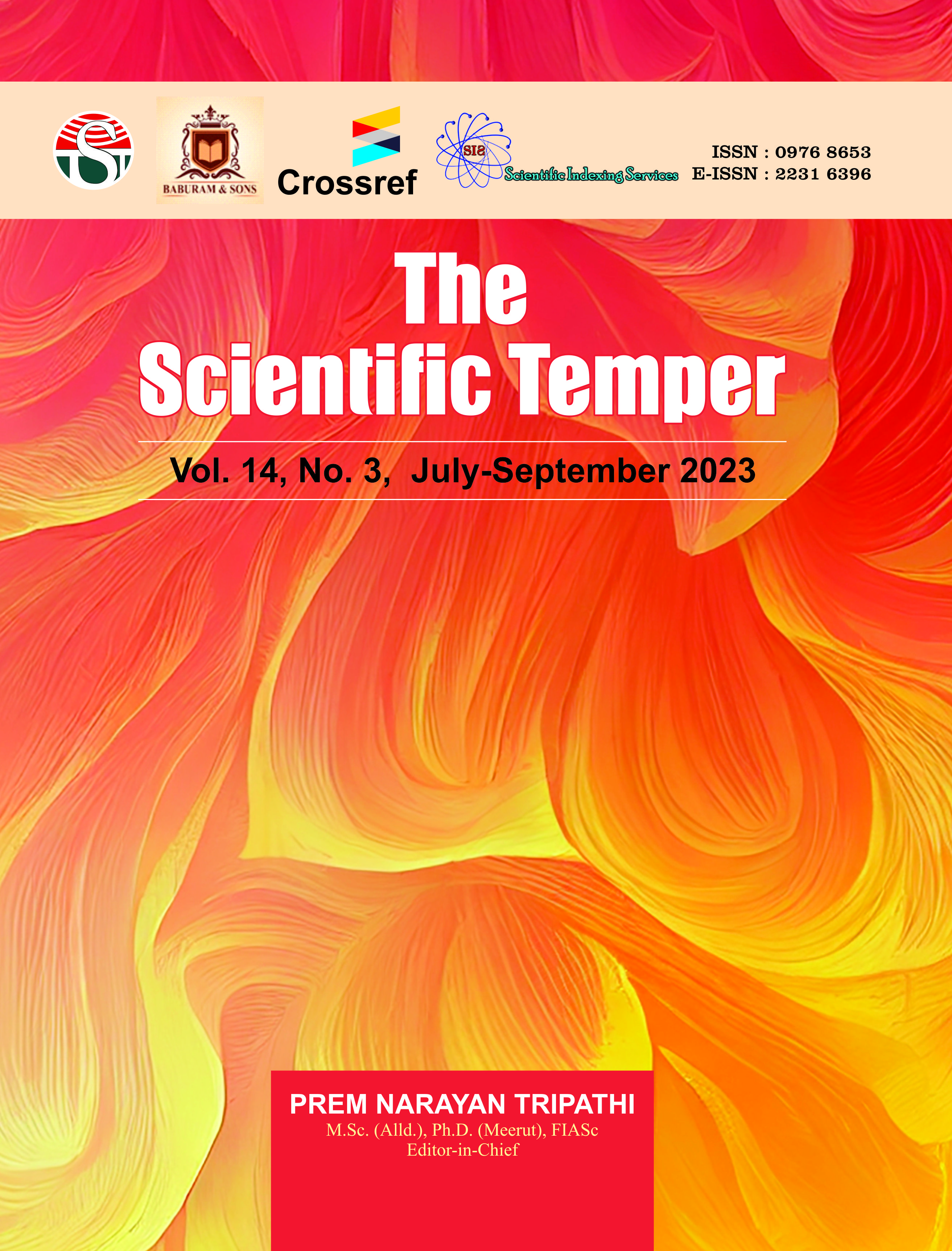Pigeonpea (Cajanus cajan L.) growth and yield with varying spacing and fertilizer
Downloads
Published
DOI:
https://doi.org/10.58414/SCIENTIFICTEMPER.2023.14.3.28Keywords:
Pigeon pea, Fertilizer, Row spacing, Yield, Fertilizer applicationDimensions Badge
Issue
Section
License
Copyright (c) 2023 The Scientific Temper

This work is licensed under a Creative Commons Attribution-NonCommercial-ShareAlike 4.0 International License.
A field experiment was conducted during kharif season of 2020 at the research farm of Amar Singh College Lakhaoti. Treatment consistedAbstract
of 3 Row spacing (30, 60 and 90 cm) and 3 levels of DAP application (control, 100 and 200 kg/ha). Results showed that treatment of
30 cm row spacing produced at par plant height compared to 60 cm row spacing. Treatment of 100 kg DAP per hectare produced
significantly plant height as compared to 200 kg DAP per hectare. The same trend was observed for a number of branches, leaves
and dry matter accumulation. Treatment of 60 cm row spacing was found to be significantly superior over 30 cm raw spacing for yield
and yield attributes treatment of 30 cm raw spacing recorded significantly higher protein content as compared to 60 cm raw spacing,
whereas treatment of 100 kg DAP per hectare was found significantly superior over control and 200 kg DAP per hectare for various
growth parameters, yield attributes and yield.
How to Cite
Downloads
Similar Articles
- M. Menaha, J. Lavanya, Crop yield prediction in diverse environmental conditions using ensemble learning , The Scientific Temper: Vol. 15 No. 03 (2024): The Scientific Temper
- Minas M. Ali, Fatema M. S. B Nuhed, Ibtihal Ahmed M Alsheikhoon, Kholood K. S Alhuthali, Ohood A. H Almalki, Effect of hyaluronic acid application on gingival black triangles– A systematic review , The Scientific Temper: Vol. 14 No. 03 (2023): The Scientific Temper
- Arvind K Shukla, Balaji V, Dharani R, M Ananthi, R Padmavathy, Romala V. Srinivas, Precision agriculture predictive modeling and sensor analysis for enhanced crop monitoring , The Scientific Temper: Vol. 14 No. 04 (2023): The Scientific Temper
- Naveen Kumar, Sunder S. Arya, Mamta Sawariya, Ajay Kumar, Neha Yadav, Jyoti Sharma, Himanshu Mehra, Unraveling the effect of salicylic acid on Vigna radiata L. under PEG- induced drought stress , The Scientific Temper: Vol. 14 No. 04 (2023): The Scientific Temper
- Rahul Maurya, Thirupataiah B, Lakshminarayana Misro, Thulasi R, Effect of the Solvent Polarity and Temperature in the Isolation of Pure Andrographolide from Andrographis paniculata , The Scientific Temper: Vol. 13 No. 02 (2022): The Scientific Temper
- B. Kalpana, P. Krishnamoorthy, S. Kanageswari, Anitha J. Albert, Machine learning approaches for predicting species interactions in dynamic ecosystems , The Scientific Temper: Vol. 15 No. 03 (2024): The Scientific Temper
- Suresh Kumar, AGRO-WASTE MANAGEMNT BY VERMICOMPOSTING USING EISENIA FETIDA AND PERIONYX SANSIBARICUS EARTHWORMS , The Scientific Temper: Vol. 9 No. 1&2 (2018): The Scientific Temper
- K. Mohamed Arif Khan, A.R. Mohamed Shanavas, Optimizing IoT application deployment with fog - cloud paradigm: A resource-aware approach , The Scientific Temper: Vol. 15 No. 04 (2024): The Scientific Temper
- S. Prabagar, Vinay K. Nassa, Senthil V. M, Shilpa Abhang, Pravin P. Adivarekar, Sridevi R, Python-based social science applications’ profiling and optimization on HPC systems using task and data parallelism , The Scientific Temper: Vol. 14 No. 03 (2023): The Scientific Temper
- ASHOK KUMAR, SADGURU PRAKASH, MARKANDEY MISHRA, MARIGOLD AS A TRAP CROP FOR THE MANAGEMENT OF TOMATO FRUIT BORER, HELICOVERPA ARMIGERA IN TARAI REGION OF UTTAR PRADESH , The Scientific Temper: Vol. 3 No. 1&2 (2012): The Scientific Temper
<< < 1 2 3 4 5 6 7 8 9 10 > >>
You may also start an advanced similarity search for this article.



